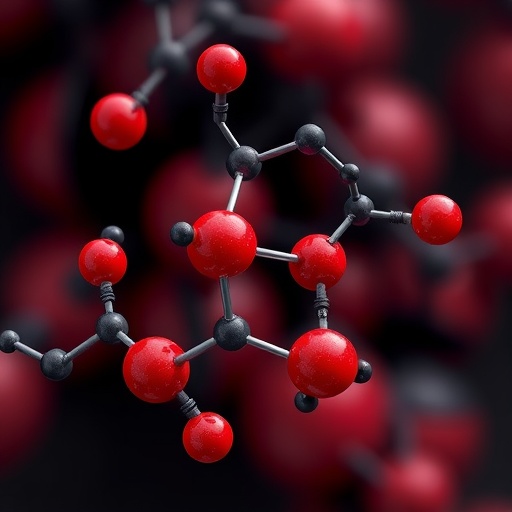In a significant leap forward in the field of medicinal chemistry, a groundbreaking study has emerged that investigates the potential of thiadiazole-based β-carboline derivatives as inhibitors of α-glucosidase. Conducted by researchers Zhou, Wen, Wang, and associates, this study promises to redefine therapeutic strategies aimed at combating diabetes and related metabolic disorders. The primary focus of the research revolves around the intricate design and synthesis of novel compounds, meticulously evaluated for bioactivity, presenting a beacon of hope for millions grappling with this chronic condition.
Diabetes management remains a global challenge, with α-glucosidase playing a crucial role in carbohydrate metabolism. By inhibiting this enzyme, it’s possible to slow down glucose absorption in the intestines, thereby contributing to better blood sugar control. This mechanism underlines the significance of α-glucosidase inhibitors, making them prime candidates for the development of new antidiabetic medications. The latest findings delve into the intricate world of molecular interactions, shedding light on how these newly synthesized compounds operate at a biochemical level.
The research team’s choice of thiadiazole as a core structure is noteworthy. Thiadiazoles are a class of bioactive compounds known for their diverse pharmaceutical applications, primarily due to their unique structures that allow for the manipulation of various biological targets. The β-carboline derivatives, on the other hand, are recognized for their potential neuroprotective and anticancer properties. By integrating these two chemical frameworks, the researchers aimed to create potent inhibitors that could effectively disrupt the activity of α-glucosidase.
The synthesis process employed by the research team is pivotal to the success of their findings. Utilizing advanced organic synthesis techniques, they meticulously created a range of thiadiazole-based β-carboline derivatives, systematically varying their chemical structures to identify which modifications enhanced their inhibitory activity. This approach not only emphasizes the importance of structure-activity relationships in drug design but also showcases the creative ingenuity required to produce novel therapeutic agents.
Upon completing the synthesis, the study proceeded to an exhaustive evaluation of the biological activity of the synthesized derivatives. This phase involved rigorous in vitro assays to assess the compounds’ ability to inhibit α-glucosidase effectively. The results were promising, revealing several derivatives with significantly enhanced inhibitory activity compared to existing α-glucosidase inhibitors. Such findings support the notion that the amalgamation of thiadiazole and β-carboline can yield new classes of therapeutic agents with superior efficacy.
Furthermore, the research emphasizes the need for such innovations in light of the ever-growing incidence of diabetes worldwide. Current medications often come with limitations, including adverse side effects and decreasing effectiveness over time. The introduction of these novel inhibitors could potentially revolutionize treatment paradigms, offering more effective alternatives for patients struggling to maintain their glucose levels.
The in-depth analysis provided by the researchers extends beyond mere synthesis and testing. By employing molecular modeling and docking studies, they were able to predict the binding affinities of the synthesized derivatives with the α-glucosidase enzyme. This computational approach complements the experimental data, offering a comprehensive understanding of how these compounds interact at the molecular level. Such insights are invaluable for guiding future drug development efforts and optimizing compound efficacy.
Safety and bioavailability remain crucial components in medicinal chemistry, and the researchers have indicated that further studies will be needed to evaluate the pharmacokinetic profiles of these novel compounds. This aspect of the research is essential, as it will determine the compounds’ potential for real-world application. Understanding how these new derivatives behave in biological systems is paramount to their successful transition from laboratory to clinic.
Moreover, the implications of this study extend beyond diabetes treatment. The structural motifs present in thiadiazole-based β-carboline derivatives may also provide a template for the development of drugs targeting other metabolic disorders and diseases linked to carbohydrate metabolism. This versatility highlights the broader significance of the research, positioning it as a potential catalyst for advancements in pharmacology and therapeutic innovation.
As the study underscores the importance of continuous exploration in drug design, it also calls for collaborative efforts among researchers in various scientific disciplines. The intersection of organic chemistry, biochemistry, and computational modeling is vital for fostering innovative solutions to pressing health challenges. The integration of these fields will only serve to accelerate the pace of discovery and enhance our understanding of complex biological systems.
Looking ahead, the researchers express optimism about the future of thiadiazole-based derivatives in pharmaceutical applications. The positive bioactivity results provide a solid foundation for subsequent research focused on optimizing these compounds for in vivo efficacy. Future investigations will likely address the pharmacodynamics and potential use in combination therapies, further underscoring their relevance in the treatment landscape.
The publication of this study marks a crucial step in the ongoing battle against diabetes and related conditions. By showcasing the potential of thiadiazole-based β-carboline derivatives, Zhou, Wen, Wang, and their team are contributing to a more profound understanding of enzyme inhibition as a viable therapeutic strategy. This research not only emphasizes the innovative approaches required to tackle complex diseases but also ignites hope for improved treatment options for patients worldwide.
In conclusion, the exploration of thiadiazole-based β-carboline derivatives represents a significant achievement in medicinal chemistry, with promising implications for diabetes management and beyond. As the research continues to evolve, it will undoubtedly pave the way for a new generation of targeted therapies, addressing unmet medical needs and potentially enhancing the quality of life for countless individuals battling chronic diseases.
Subject of Research: Thiadiazole-based β-carboline derivatives as inhibitors of α-glucosidase.
Article Title: Thiadiazole based β-carboline derivatives as potential α-glucosidase inhibitors: design, synthesis, and bioactivity evaluation.
Article References:
Zhou, H., Wen, Y., Wang, SH. et al. Thiadiazole based β-carboline derivatives as potential α-glucosidase inhibitors: design, synthesis, and bioactivity evaluation. Mol Divers (2025). https://doi.org/10.1007/s11030-025-11369-2
Image Credits: AI Generated
DOI: 10.1007/s11030-025-11369-2
Keywords: thiadiazole, β-carboline, α-glucosidase inhibitors, diabetes, medicinal chemistry, drug design, bioactivity evaluation, structure-activity relationships, pharmacokinetics, enzyme inhibition.
Tags: bioactive compound synthesisbiochemical interactions in drug designcarbohydrate metabolism regulationchronic condition management in diabetesdiabetes management strategiesglucose absorption inhibitionmedicinal chemistry advancementsnovel antidiabetic medicationspharmaceutical applications of thiadiazolestherapeutic strategies for metabolic disordersthiadiazole β-carboline derivativesα-glucosidase inhibitors





